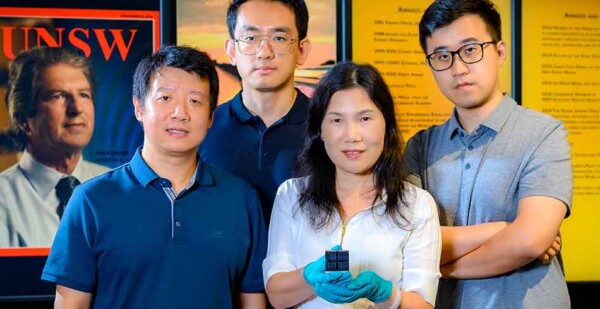Engineers at the University of New South Wales (UNSW) have broken a world record with the kesterite solar cell—a specific type of solar cell that has been touted as a potential long-term improvement in photovoltaic (PV) technology.
Solar researchers around the world are working to find the best material to combine with traditional silicon cells to form a tandem solar cell, which can boost efficiency compared to single junction solar cell.
Related article: How much rooftop solar capacity can Australia handle?
Scientia Professor Xiaojing Hao and her team from UNSW’s School of Photovoltaic and Renewable Energy Engineering have achieved a best-ever efficiency of 13.2% for high bandgap kesterite solar cells, which had been enhanced with hydrogen.
Kesterite is naturally occurring mineral but can also be artificially created at low cost by combining copper, zinc, tin and sulphur—which are not only all hugely abundant, but are also non-toxic.
The names of the component parts are why, in its synthesised form, kesterite is known as CZTS. CZTS is a promising material for future generations of solar cells because it is environmentally friendly, cost-effective to manufacture, and is known to maintain its photovoltaic performance over a long period of time. However, its efficiency has been long-hampered, largely by the number of defects created within CZTS during production, which are hard to avoid.
The UNSW team, including Dr Kaiwen Sun and Dr Jialiang Huang, say they have helped to solve this problem by annealing, or heat-treating, the CZTS solar cell device in a hydrogen-containing atmosphere.

The fundamental research behind the record-breaking efficiencies, which first achieved 11.4% after six years of stagnation for CZTS, has now been published in the Nature Energy journal.
“The big picture here is that we ultimately want to make electricity cheaper and greener to generate,” says Prof. Hao.
“Silicon modules have almost reached the limit of their theoretical efficiency, so what we are trying to do is answer the question coming from the PV industry as to what the next generation of cells will be made of.
“And as well as that, how can we make solar panels less expensive to manufacture, and how can we get more electricity per area so the panels can be particularly beneficial for area-limited PV applications?”
Prof. Hao says she is hopeful the new breakthrough will accelerate the chances of CZTS reaching 15% efficiency within the next year, and expects its commercialisation by 2030.
Related article: Sydney Ferry named after solar pioneer Prof Martin Green
“There is still work to be done to find ways to further reduce the defects we find in CZTS, either during the fabrication or via post-fabrication treatments,” she says.
“But we know that this is a good material. When we consider the requirements from the bottom up, we know that we need something that is widely abundant, that is environmentally friendly, that has good optoelectronic properties and can last a long time— and CZTS fits the bill.”







